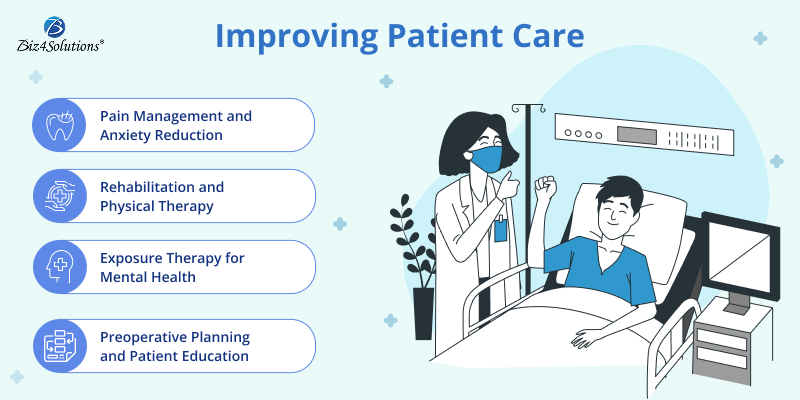
Virtual reality (VR) is reshaping industries across the world, and healthcare is one of the most exciting frontiers. From helping doctors refine their surgical skills to easing patient anxiety during treatment, VR is revolutionizing both medical training and patient care. By creating realistic, immersive environments, it allows medical professionals to learn, experiment, and treat in ways that were once impossible. Let’s explore how VR is driving this transformation.
Transforming Medical Training

1. Enhanced Learning Experiences
Traditional medical training depends heavily on lectures, textbooks, and cadaver studies. VR takes learning to the next level by placing students inside 3D interactive environments where they can explore human anatomy and practice procedures virtually. This hands-on approach bridges the gap between theory and real-life application, allowing learners to absorb concepts faster and retain them longer.
2. Risk-Free Surgical Practice
One of VR’s greatest strengths is that it enables doctors to practice complex surgeries without putting patients at risk. Surgeons can simulate delicate or high-stakes operations repeatedly until they perfect their techniques. This virtual practice builds confidence and enhances surgical precision before ever stepping into an operating room.
3. Remote Collaboration and Training
VR has made medical education truly borderless. Students and professionals can now participate in training sessions from anywhere in the world. This global accessibility ensures that high-quality medical instruction and collaboration are no longer limited by geography, fostering a richer exchange of expertise across institutions and countries.
4. Personalized Learning Paths
Every learner is different, and VR recognizes that. By adapting to the user’s skill level and progress, it offers tailored learning experiences. A beginner might start with simple procedures, while an experienced surgeon can focus on mastering advanced or rare techniques. This personalization ensures that every professional learns at their own pace.
Improving Patient Care

1. Pain Management and Anxiety Reduction
VR isn’t just for doctors, it’s transforming the patient experience too. During painful or stressful procedures like wound care or physiotherapy, patients can be immersed in soothing virtual worlds that distract them from discomfort. Studies have shown that this form of distraction therapy significantly reduces both pain perception and anxiety.
2. Rehabilitation and Physical Therapy
Rehabilitation can often feel repetitive and tiring, but VR is changing that. By turning therapy into interactive and gamified sessions, patients stay more motivated and engaged. VR systems can also monitor progress and give instant feedback, helping therapists customize programs for faster recovery.
3. Exposure Therapy for Mental Health
In mental health treatment, VR is proving invaluable for exposure therapy. Patients coping with PTSD, phobias, or anxiety can safely face their fears through realistic virtual simulations, all under professional supervision. This controlled exposure helps them build coping mechanisms and confidence before confronting real-life situations.
4. Preoperative Planning and Patient Education
For surgeons, VR offers a way to visualize complex cases in three dimensions before the first incision is made, improving accuracy and reducing complications. It’s also an excellent tool for patient education: doctors can use VR models to explain upcoming procedures, helping patients understand their treatment and feel more at ease.
Challenges and Future Prospects
Like any emerging technology, VR in healthcare isn’t without its hurdles. High setup costs, technical limitations, and the lack of universal standards can make adoption difficult. Yet, as hardware becomes more affordable and software more refined, these challenges are steadily being addressed.
The future looks even more promising with the integration of VR, artificial intelligence (AI), and augmented reality (AR). Together, these technologies could unlock hyper-realistic training modules, intelligent treatment recommendations, and even immersive remote consultations; reshaping healthcare delivery as we know it.
Conclusion
Virtual reality has opened a new chapter in the story of modern medicine. It’s redefining how healthcare professionals learn, practice, and connect with patients, all while improving outcomes and experiences. As VR continues to evolve, its potential to transform medical training and patient care is boundless, marking an exciting step forward for both medicine and technology.
Virtual Reality is no longer just about immersive gaming; it’s reshaping the way we learn, heal, and deliver care.
